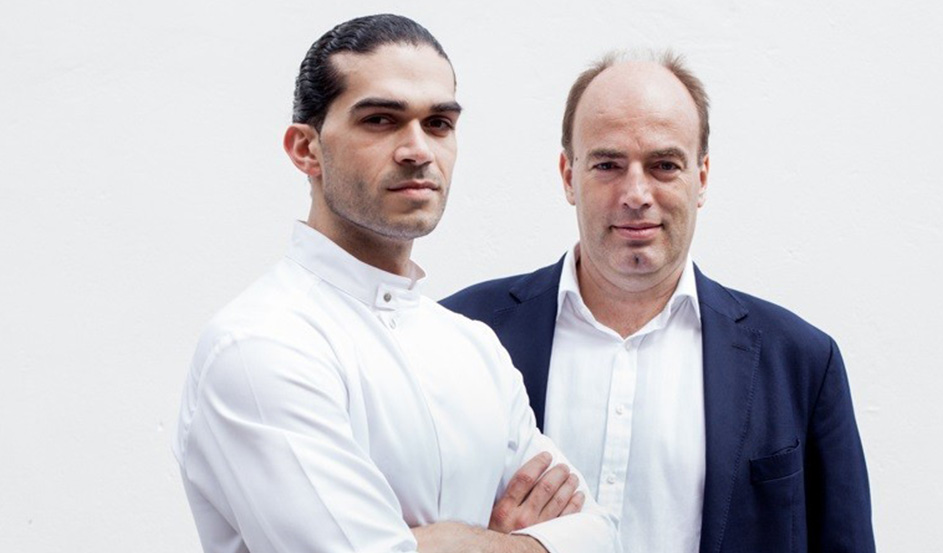
THE CHEF & THE SCIENTIST – ON A MISSION TO CHANGE THE WAY WE EAT
Can we solve the world’s growing health issues using Multisensory Gastronomy? The Chef & The Scientist think we can.
We are in exciting times for gastronomy; there are a growing number of chefs all over the world who are venturing out of the kitchen to collaborate with artists, architects, designers, musicians and, of course, scientists. These unique collaborations can sometimes lead to the most incredible gastronomy related projects and concepts, opening our eyes and minds to the possibilities of food and dining in the future.
Kitchen Theory’s founding chef, Jozef Youssef, is one such chef, and his journey on the path towards finding a greater purpose for his culinary craft started back in 2011 when he attended a seminar entitled ‘Multi-Sensory Flavour Perception’. Professor Charles Spence, head of the Cross Modal Research Laboratory at Oxford University’s Department of Experimental Psychology was one of the speakers that evening. His research into gastronomy from a neurological perspective was unlike anything Jozef had previously encountered, and certainly fuelled what has now become a central part of Kitchen Theory’s philosophy and approach towards gastronomy. This chance encounter led to the two becoming acquainted and has resulted in a most interesting of collaborations; ‘The Chef & The Scientist’.
Over the past couple of years, the Kitchen Theory team have been developing dining concepts that are aimed not only at giving their guests a great food experience, but at delivering a truly memorable multisensory dining experience.
We believe humans can only make sense of life, interact and communicate using their senses – we have no other way of receiving information about the world around us – which forms our perspective and reality. Life therefore can be seen as a continuous series of multisensory experiences, which create our existence.
But, until recently, no one has looked at our relationship with food through such a lens. We understand the importance of our senses of taste and smell, and how they contribute to our experience of food. However we seem to discount the rest. A point Charles has made in the past is that; one thing to bear in mind is that there is quite some disagreement in the field as to how ‘flavour’ should be defined. While some researchers would prefer that the term be restricted to gustation (taste), retronasal olfaction (smell), and possibly also trigeminal inputs (the tingle you get from menthol or chilli), others have suggested that the sense of hearing and vision should also be incorporated. As you can imagine the Kitchen Theory team fall very much into the latter category.
Sound and audio stimulation, tactile sensations and temperature, as well as visual presentation all exert a profound influence on our multisensory experience of food and drink! Why do we say so? Well, partially because it’s intuitive and makes sense, but also because there is now a growing body of empirical work that is uncovering the importance of these other senses in terms of shaping our perceptions of food and dining experiences.
Do you want to eat crisps with no crunch? An Irish stew served cold? A Michelin starred meal off paper plates with plastic cutlery? How about listening to a screeching violin while eating your sweet dessert? Chances are you answered no to all the above, and there is good reason behind your responses. Our goal is driven by wanting to find out why these suggestions are all incongruent and how we can work towards developing that ‘perfect’ meal. We want to know what factors make up a delicious and memorable dining experience and what patterns are to be found.
Most importantly we seek to understand the relationship we have with food, how we relate to and interact with it, how we use our senses to make sense of it and put it in context. In doing we so we hope to find ways of solving some of the most challenging health problems that the world is currently facing including; malnutrition, childhood obesity, diabetes and weight loss.
With a growing understanding of how we as humans, understand, interact and relate to food, there is the potential to use these findings to guide people towards making more nutritious and sustainable food choices. So far; the chef and the scientist have found:
- we have almost synesthetic colour and taste associations (red is sweet, while green is sour or bitter)
- textural stimulation in the hand can alter the mouthfeel or taste of foods (with rougher textures making a dish crunchier, saltier or more bitter, while soft textures bring out sweeter, creamier notes)
- different sounds can effect our perception of foods (with particular notes and tones being linked to particular taste sensations) which has led to Professor Spence coining the term ‘Sonic Seasoning’
- the plating of a dish can alter our enjoyment of its perceived flavour
- the flavour of a dish can be totally transformed based on external aromas being sprayed in the air
- the shape, texture and colour of foods as well as how we identify them alters our enjoyment eating them (if a pink scoop of sorbet you think is strawberry turns out to be smoked salmon flavoured your reaction is guaranteed to be negative, whereas if you were informed of the flavour your approval rating is much more likely to be positive).
So how does all this tackle the growing nutritional and sustainability issues we are facing in today’s world?
In a study conducted by professor Spence with the Alicia foundation it was found that dinners who ate an identical red mousse off both a black plate and a white plate rated the mousse to be up to 12% sweeter when it was served on the white plate! With this in mind would it not be possible to reduce the amount of sugar in a dish or food product simply by augmenting the colour of the food or even the packaging, in doing so it may allow the consumer to believe they are enjoying the same level of sweetness without all the sugar!
What about our growing concern with high sodium levels in processed foods. Research which is currently being conducted would suggest that rougher textures such as sandpaper bring out saltiness in a dish. This may mean that simply eating with a slightly grainy textured spoon would allow us to reduce the salt in our diet without really feeling its absence!
As for sustainability; in the past few years the world has become more familiar with the concept that entomophagy (eating insects) offers a more sustainable source of protein in comparison to intensive animal farming. However in many countries around the world we simply do not see insects as food, to many people the idea is repulsive. The chef and the scientist have been working to overcome this negative perception by developing a worm butter which they served to Kitchen Theory’s guests at the start of their meal with the bread. They used butter as a medium for delivering the worm for several reasons; it took the insect out of its natural form, butter is an ingredient they knew their guests would be familiar with and most importantly we all like the fatty creamy flavour of butter. Much to their surprise the worm butter was consumed in higher volume than the salted butter served along side it and most interestingly a high number of vegetarians ate the butter!
This now brings us back to their current work; last year Charles joined Kitchen Theory’s board of directors and has been working closely with chef Jozef on developing our sell-out ‘Synaesthesia by Kitchen Theory’ dining concept which ran between February and July, 2015. The duo have since had number of academic papers published in peer-reviewed journals and have travelled around Europe to host a number of talks on their work. Their plan is to focus their efforts on taking the research to a wider audience, bridging the gap between academia and the outside world, and making it all so much more accessible; through a variety of talks, dinners, networking events, and online content.
For the remainder of the year The Chef & The Scientist are particularly focused on their upcoming ‘sensory manifesto’ as well as research in the area of the relationship between tactile sensations and its effects on mouthfeel and flavour, as well as the impact of sound and scent on eating and dining experiences. All of which will be channelled into Kitchen Theory’s next dining concept entitled ‘Mexico by Kitchen Theory’ a modernist, multisensory interpretation of Mexican cuisine and culture.


Leave a Reply